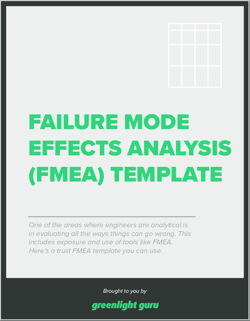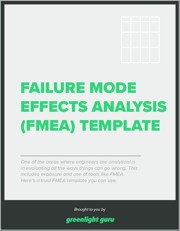Failure Mode Effects Analysis: What Is It & When Should You Use It?

Failure mode effects analysis (FMEA) is one of the best-known risk management tools within engineering.
It’s a classic method for identifying the risks of failure in a product or process, assessing their effects, and coming up with solutions to eliminate or mitigate them. That said, it’s not the only risk management tool out there, and for medical device manufacturers, it may not always be the best option.
Here’s what you need to know about failure mode effects analysis—and whether you should be using it:
BONUS RESOURCE: Click here to download your free failure mode effects analysis (FMEA) template.
What is failure mode effects analysis (FMEA)?
Failure mode effects analysis is a systematic risk management tool for identifying the possible failures that may exist in your products or your processes.
The easiest way to understand failure mode effects analysis is by breaking down the name:
-
Failure Mode refers to the ways in which a product or process can fail.
-
Effects are the potentially harmful consequences of a failure.
-
Analysis is the study of the failure modes and their effects. This uses a failure mode’s severity, frequency of occurrence, and chance of detection.
There are several types of failure mode effects analysis, but the two most important are Design FMEA and Process FMEA. Both attempt to identify potential problems early on and minimize the chance of occurrence, but they are used in different situations.
-
Design FMEA assesses the risks of new or modified product designs and helps to minimize any effects of product failure on the end user.
-
Process FMEA is used to uncover any risks associated with process implementation or changes and mitigate or eliminate their potential effect on the product.
how does failure mode effects analysis work?
A basic failure mode effects analysis consists of scoring three areas on a scale of 1-10 (from lowest to highest) and then multiplying the scores to receive a risk priority number (RPN). The higher the RPN, the higher the priority.
The three areas you must score to get your RPN are:
-
Severity (SEV) - This score is the severity of the consequences of a given failure mode. For example, a minor cosmetic defect would likely be scored very low. However, some effects—like the failure of an implantable device that is keeping someone alive—could be catastrophic in failure mode and would be given a high score.
-
Occurrence (OCC) - This represents the likelihood that the failure mode will occur. Using the same example from above, while the failure of the implantable device may lead to severe consequences, it may also be very unlikely; therefore, it would be given a low frequency score. On the other hand, if the minor cosmetic issue occurs regularly, it would be given a much higher score.
-
Chance of detection (DET) - This score represents how well your current processes for detecting failure work. A high score here means you have little to no ability to detect a failure mode. If there is no process for detecting a failure mode, it should be given a score of 10.
Keep in mind that the scoring of these areas is subjective. So, when you’re conducting an FMEA, it’s important to assemble a cross-functional team composed of people with at least a baseline knowledge of the design or process you are evaluating.
Should medical device companies use FMEA or ISO 14971 for risk management?
The answer to this question isn’t cut and dried. Failure mode effects analysis is an effective tool for assessing failure modes, however, medical device manufacturing requires risk management techniques that can identify and mitigate systemic issues as well as individual failure modes.
This is why ISO 14971:2019, the internationally recognized standard for medical device risk management, exists. It offers medical device professionals a holistic approach to managing risk based on a rational assessment of all known risks a device poses.
One big differentiator of the risk management standard from failure mode effects analysis is that ISO 14971 uses the terms hazard, hazardous situation, and harm to define risk. The difference here is not just semantics though.
In order for a hazard to become a harm, you need a hazardous situation to occur. An important thing to know about failure mode effects analysis is that risk is often overestimated with this approach because it’s assumed that a failure mode automatically leads to a harm. For medical devices, specifically, this just isn’t how the progression works.
ISO 14971 dives deeper into the progression, breaking the probability of occurrence of harm into two separate variables:
-
Probability of a hazardous situation occurring
-
Probability of a hazardous situation leading to harm
According to the risk management standard, even though a hazard may be present, the possibility that it will lead to a hazardous situation may be low. What’s more, the possibility that the hazardous situation will lead to harm may also be low.
Failure mode effects analysis, on the other hand, assumes that a failure mode leads directly to harm, which does not accurately depict the nature of the risk. For an excellent, in-depth explanation of this difference, I’d encourage you to read our previous blog post on risk assessment that explains the difference between the two.
The bottom line is that medical device manufacturers shouldn’t rely solely on failure mode effects analysis for risk management. It’s a useful tool, but one that should be used as part of a broader risk management strategy with ISO 14971 at its core.
BONUS RESOURCE: Click here to download your free failure mode effects analysis (FMEA) template.
Integrate risk management throughout your medical device lifecycle with Greenlight Guru
Risk management is an essential part of bringing a safe, effective medical device to market and keeping it there long term. It is because of this that regulatory bodies around the world emphasize a risk-based approach be taken throughout the lifecycle of a medical device. The best way to do this is by utilizing industry-specific tools that are built on those same principles.
At Greenlight Guru, we created our QMS software specifically for the medical device industry and it is the only solution that aligns directly with ISO 14971:2019.
Greenlight Guru’s dedicated Risk Management Software reduces the stress of audits and inspections by integrating risk-based thinking into your entire quality ecosystem, keeping you in compliance with the latest risk management practices from ISO 14971:2019 and risk-based requirements of ISO 13485:2016.
If you’re looking for a purpose-built solution that integrates risk management throughout your entire product lifecycle, then get your free demo of Greenlight Guru today.
Looking for a design control solution to help you bring safer medical devices to market faster with less risk? Click here to take a quick tour of Greenlight Guru's Medical Device QMS software
Ryan Behringer is a Medical Device Guru and Biomedical Engineer who prides himself on adding value in all areas of bringing a medical device to market. He has R&D, Product Development, Quality, and Sustaining Engineering experience, even utilizing Greenlight Guru to achieve 510(k) clearance, from startups to mid-sized...
Related Posts
Why Use ISO 14971 vs. FMEA (Template Included)
Why FMEA is Not ISO 14971 Risk Management
How to Use an FMEA Template as Part of Your Medical Device Risk Management
Get your free template
Failure Mode Effects Analysis (FMEA) Template










